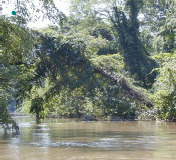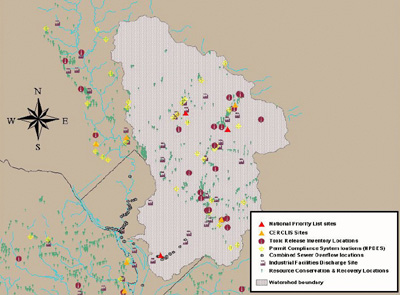Anacostia Watershed
The Anacostia Watershed is an example of a large scale, area wide contamination problem that is successfully being addressed by the voluntary collaboration and partnership of public and private programs. The Anacostia watershed spans three main jurisdictions: Prince George and Montgomery Counties in Maryland and the District of Columbia.

Background
In 1999, EPA convened the Anacostia Watershed Toxics Alliance (AWTA), a coalition of over 25 different groups, agencies, and institutions, to address the complex environmental issues in the Anacostia watershed.
Assessment and cleanup of the Anacostia watershed and river is challenging because of its size (176 square miles), the numerous contaminant sources, and the complexity of tidal flow. Some of the major environmental problems include:
Nonpoint source runoff
Storm water problems
Contaminated sediments
Loss of natural habitat for fish
The objective of AWTA is to investigate toxic substances that present an unacceptable risk to human health and the environment, and develop and implement a comprehensive contaminated sediment management strategy.
AWTA is also working closely with environmental groups and regulatory agencies looking at other problems affecting the river such as total maximum daily loadings, combined sewer overflow releases, and trash.
What Makes the AWTA Approach Unique?
The AWTA is based on the assumption that studies and remedies can be performed more effectively and efficiently through the cooperative efforts of many. By pooling available fiscal and technical resources, AWTA has been able to support a watershed-based approach to address the problem of contaminated sediments in the Anacostia River.
The work being done here is innovative in that it does not mimic EPA=s normal operating approach. The hazardous contaminants fouling the Anacostia watershed are being investigated and addressed, not by Superfund or potentially responsible parties alone, but by over 25 public and private volunteer stakeholders, who are performing this work without the issuance of judicial or administrative orders. The net effect has been an accelerated effort to secure scientific understanding of the problem and consensus on a strategy for cleanup.
Funding
The AWTA effort at this point has leveraged almost $20 million in private and other public support which is greatly accelerating the pace of efforts to address this difficult problem.
Transferability
The AWTA approach is being shared with local watershed committees of the Elizabeth River Project of Virginia where very similar issues persist. EPA Region III began a concerted effort to partner with the Elizabeth River Project through a kick off meeting in June 2002. These urban river restoration pilots may be transferable to many other areas where sediment contamination and urban river management issues exist.

Status
The approach has been widely embraced and AWTA is sustaining itself through the full support and ownership of its many partners. Monthly meetings rotate among members and subgroups tackle various issues. It has been successful in leveraging considerable private and public resources.
A three-phased approach with an aggressive schedule is being executed:
- Phase I (complete) consisted of a compilation and evaluation of existing data from various investigations in the Anacostia River
- Phase II (complete) focused on investigations designed to address critical data gaps
- Phase III (underway) is the development and implementation of a comprehensive contaminated sediment management strategy with associated cost estimates.
Interim Results
Not waiting for the final strategy to be completed, ATWA members have been effectively cleaning up their sites and stopping the flow of contaminants to the river. Through their efforts, they have:
- repaired over 6.5 miles of leaking storm sewers,
- constructed 6 sand filters to reduce trash flow to the river,
- built protective covers over 30 acres to reduce contaminate migration,
- removed over 7,500 gallons of coal tar, 20,000 gallons of petroleum, and 25 pounds of mercury
- abated over 27,000 tons of contaminated soil and 1 million gallons of surface and groundwater.
For additional information:
| Catherine King - EPA Region III | (215) 814-2657 |
| Jon Capacasa - EPA Region III | (215) 814-5422 |
![[logo] US EPA](../gif/logo_epaseal.gif)